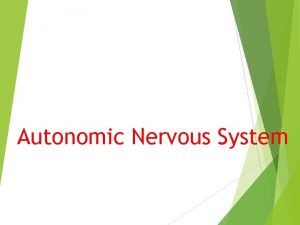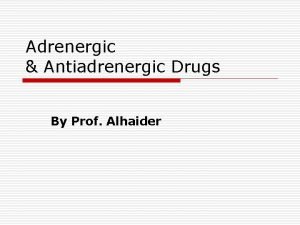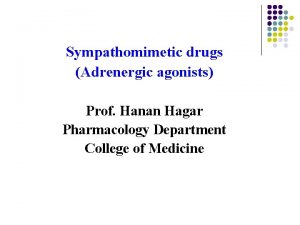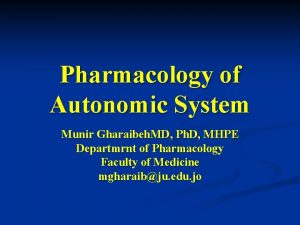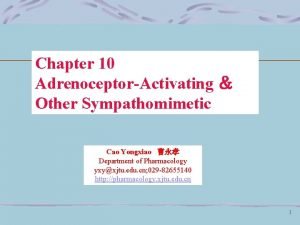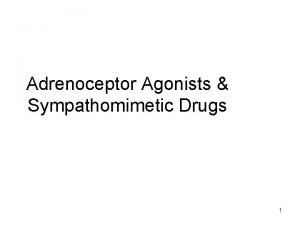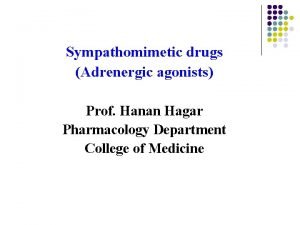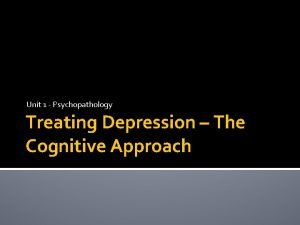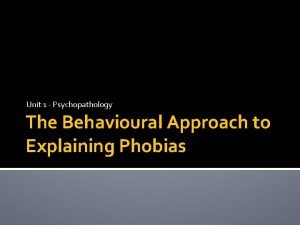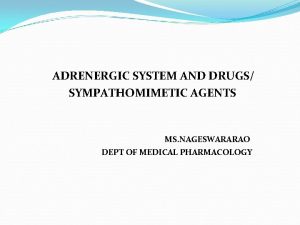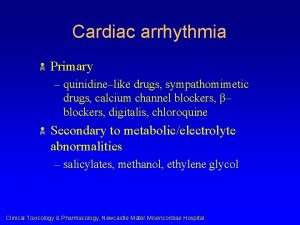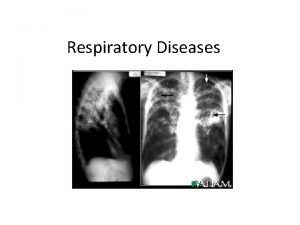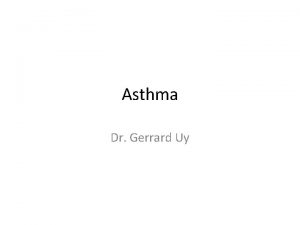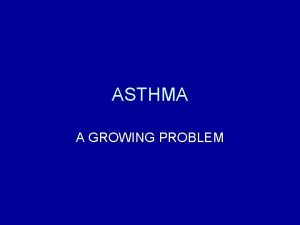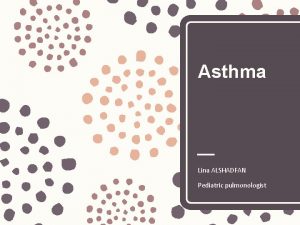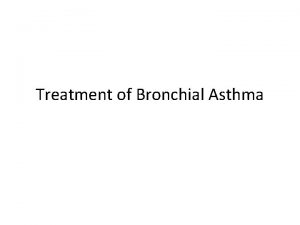Drugs For Treating Asthma Chapter 9 Sympathomimetic Agents














- Slides: 14

Drugs For Treating Asthma Chapter 9

Sympathomimetic Agents • Noninfectious respiratory diseases are divided into two groups – Asthma is characterized by reversible airway obstruction – Chronic obstructive pulmonary disease (COPD) is characterized by irreversible airway obstruction • COPD is further divided into emphysema and chronic bronchitis

Sympathomimetic Agents - Continued • Beta-Adrenergic Agonists – Nonselective adrenergic agonist drugs stimulate beta receptors in the lungs and heart and alpha receptors in the heart – Epinephrine and isoproterenol are nonselective adrenergic agonists – Today, short- and long-acting β 2 -agonists are used to treat asthma and COPD – Β 2 -Agonists stimulate receptors in the lungs. – Stimulation of these receptors produces bronchodilation – Adverse effects include nervousness, tachycardia, and insomnia

Respiratory Drugs • Beta-Adrenergic Agonists – Short-Acting β 2 -Agonists • These drugs are used to treat acute asthma attacks. • They are usually administered via metered dose inhalers • They are available in tablet and liquid dose forms. • Short-acting β 2 -agonists are often used as prophylaxis prior to exercise or another known precipitating event

Long-Acting β 2 -Agonists • These agonists have a delayed onset of action and a longer duration of action • Onset of action is within 10 -20 minutes and the duration of action of 12 hours. • These drugs are used as maintenance therapy in the treatment of asthma and COPD

Metered Dose Inhalers (MDI) • These devices deliver the medication directly to the bronchioles • The total dose is kept low and side effects should be minimal • The inhaled dose can be accurately measured • Onset of action is rapid and predictable • They are compact, portable, and sterile • They can be difficult to use • Spacers are available which makes the inhaler easier to use • Adverse effects with MDI use include dry mouth

Corticosteroids • Steroids reduce the inflammation associated with airway obstruction – They also inhibit the release of inflammatory substances – Steroids are available as MDIs and oral and liquid dose forms – The MDI has become the most common dose form used in treating asthma and COPD

Corticosteroids - Continued • Corticosteroids significantly improve pulmonary function with a decrease in wheezing, tightness, and cough – These drugs are not used for acute attacks. – Chronic oral prednisone use is reserved for patients with severe asthma – Adverse effects are dependent upon dose form, frequency of intake, total dose, and any preexisting conditions

Corticosteroids - Continued • Prolonged systemic use can lead to adrenal suppression, poor wound healing, and immunosuppression – MDI use can lead to oral candidiasis. – Patients using inhaled steroids should be instructed to brush, floss, rinse, and spit, after each use

Leukotriene-Pathway Inhibitors • These drugs work by either preventing the synthesis of leukotrienes or by blocking leukotriene receptors – Leukotriene release produces bronchoconstriction, increased mucus secretion, mucosal edema, and increased bronchial hyperreactivity – These drugs are used to treat asthma and allergic rhinitis – Adverse reactions include irritation of the stomach mucosa, headache, and altered liver function tests

Cromolyn • Cromolyn inhibits mast cell degranulation. – It is used for the prophylaxis of asthma – It can be used in patients with chronic asthma or taken before exercise-induced asthma – Adverse effects include cough, dry mouth, nausea, and headache – It is available as a nebulizer or in a spinhaler dose form

Methylxanthines • Theophylline is the main drug in this category – It is a bronchodilator with a narrow therapeutic window – It is used to treat severe asthma and the bronchospasm associated with COPD – Side effects include CNS stimulation, cardiac stimulation, and GI upset

Anticholinergic Drugs • Ipratropium bromide is an inhaled anticholinergic drug that is used to treat asthma and COPD – Its anticholinergic effects produce a bronchodilating effect in the lungs – Side effects include dry mouth. The patient should rinse after each inhaler use to minimize dry mouth

Role of the Athletic Trainer • Educate the patient in regards to: – The type of medication they are taking – Specific effects in regard to athletic performance • Understand proper inhalation technique • Take action to adjust specific drug through consultation if necessary • Keep medication readily available • Monitor the patient during exercise • Know the medications the athletes are using
 Sar of adrenergic antagonist
Sar of adrenergic antagonist Sympathomimetic agents
Sympathomimetic agents Sympathomimetic drugs
Sympathomimetic drugs Non catecholamine function
Non catecholamine function Sympathomimetic agents
Sympathomimetic agents Sympathomimetic drugs
Sympathomimetic drugs Sympathomimetics
Sympathomimetics Sympathomimetic drugs
Sympathomimetic drugs Pathophysiology definition
Pathophysiology definition Chapter 24 lesson 2 preventing and treating stds
Chapter 24 lesson 2 preventing and treating stds Tumor treating fields mechanism of action
Tumor treating fields mechanism of action Cognitive approach to treating depression
Cognitive approach to treating depression Ethical issues in treating lgbt patients
Ethical issues in treating lgbt patients Behaviourist approach to explaining phobias
Behaviourist approach to explaining phobias Tcf training
Tcf training

